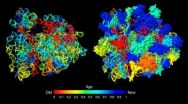(Press-News.org) CHAMPAIGN, Ill. — In the beginning – of the ribosome, the cell's protein-building workbench – there were ribonucleic acids, the molecules we call RNA that today perform a host of vital functions in cells. And according to a new analysis, even before the ribosome's many working parts were recruited for protein synthesis, proteins also were on the scene and interacting with RNA. This finding challenges a long-held hypothesis about the early evolution of life.
The study appears in the journal PLoS ONE.
The "RNA world" hypothesis, first promoted in 1986 in a paper in the journal Nature and defended and elaborated on for more than 25 years, posits that the first stages of molecular evolution involved RNA and not proteins, and that proteins (and DNA) emerged later, said University of Illinois crop sciences and Institute for Genomic Biology professor Gustavo Caetano-Anollés, who led the new study.
"I'm convinced that the RNA world (hypothesis) is not correct," Caetano-Anollés said. "That world of nucleic acids could not have existed if not tethered to proteins."
The ribosome is a "ribonucleoprotein machine," a complex that can have as many as 80 proteins interacting with multiple RNA molecules, so it makes sense that this assemblage is the result of a long and complicated process of gradual co-evolution, Caetano-Anollés said. Furthermore, "you can't get RNA to perform the molecular function of protein synthesis that is necessary for the cell by itself."
Proponents of the RNA world hypothesis make basic assumptions about the evolutionary origins of the ribosome without proper scientific support, Caetano-Anollés said. The most fundamental of these assumptions is that the part of the ribosome that is responsible for protein synthesis, the peptidyl transferase center (PTC) active site, is the most ancient.
In the new analysis, Caetano-Anollés and graduate student Ajith Harish (now a post-doctoral researcher at Lund University in Sweden) subjected the universal protein and RNA components of the ribosome to rigorous molecular analyses – mining them for evolutionary information embedded in their structures. (They also analyzed the thermodynamic properties of the ribosomal RNAs.) They used this information to generate timelines of the evolutionary history of the ribosomal RNAs and proteins.
These two, independently generated "family trees" of ribosomal proteins and ribosomal RNAs showed "great congruence" with one another, Caetano-Anollés said. Proteins surrounding the PTC, for example, were as old as the ribosomal RNAs that form that site. In fact, the PTC appeared in evolution just after the two primary subunits that make up the ribosome came together, with RNA bridges forming between them to stabilize the association.
The timelines suggest that the PTC appeared well after other regions of the protein-RNA complex, Caetano-Anollés said. This strongly suggests, first, that proteins were around before ribosomal RNAs were recruited to help build them, and second, that the ribosomal RNAs were engaged in some other task before they picked up the role of aiding in protein synthesis, he said.
"This is the crucial piece of the puzzle," Caetano-Anollés said. "If the evolutionary build-up of ribosomal proteins and RNA and the interactions between them occurred gradually, step-by-step, the origin of the ribosome cannot be the product of an RNA world. Instead, it must be the product of a ribonucleoprotein world, an ancient world that resembles our own. It appears the basic building blocks of the machinery of the cell have always been the same from the beginning of life to the present: evolving and interacting proteins and RNA molecules."
"This is a very engaging and provocative article by one of the most innovative and productive researchers in the field of protein evolution," said University of California at San Diego research professor Russell Doolittle, who was not involved in the study. Doolittle remains puzzled, however, by "the notion that some early proteins were made before the evolution of the ribosome as a protein-manufacturing system." He wondered how – if proteins were more ancient than the ribosomal machinery that today produces most of them –"the amino acid sequences of those early proteins were 'remembered' and incorporated into the new system."
Caetano-Anollés agreed that this is "a central, foundational question" that must be answered.
"It requires understanding the boundaries of emergent biological functions during the very early stages of protein evolution," he said. However, he said, "the proteins that catalyze non-ribosomal protein synthesis – a complex and apparently universal assembly-line process of the cell that does not involve RNA molecules and can still retain high levels of specificity – are more ancient than ribosomal proteins. It is therefore likely that the ribosomes were not the first biological machines to synthesize proteins."
Caetano-Anollés also noted that the specificity of the ribosomal system "depends on the supply of amino acids appropriately tagged with RNA for faithful translation of the genetic code. This tagging is solely based on proteins, not RNAs," he said. This suggests, he said, that the RNA molecules began as co-factors that aided in protein synthesis and fine-tuned it, resulting in the elaborate machinery of the ribosome that exists today.
INFORMATION:
The National Science Foundation and the United Soybean Board supported this research.
Editor's notes: To reach Gustavo Caetano-Anollés, call 217-333-8172; email gca@illinois.edu.
The paper, "Ribosomal History Reveals Origins of Modern Protein Synthesis," is available online and from the U. of I. News Bureau.
Study of ribosome evolution challenges 'RNA World' hypothesis
2012-03-13
ELSE PRESS RELEASES FROM THIS DATE:
Common North American frog identified as carrier of deadly amphibian disease
2012-03-13
AUDIO:
This is an audio recording of the distinctive "ribbit " call of the Pacific chorus frog (28 seconds long, MP3 file, WAV file available on request).
This noisy frog is a potent...
Click here for more information.
Known for its distinctive "ribbit" call, the noisy Pacific chorus frog is a potent carrier of a deadly amphibian disease, according to new research published today in the journal PLoS ONE. Just how this common North American frog survives chytridiomycosis ...
March/April 2012 Annals of Family Medicine tip sheet
2012-03-13
Four articles in the current issue draw attention to policy initiatives and implications of the rapidly changing U.S. health care environment. Collectively, they examine some of the challenges and opportunities facing the country following the 2010 passage of the Patient Protection and Affordable Care Act.
Researchers Project Cost of Family Health Insurance Premiums Will Surpass Household Income by 2033
Updating estimates of who will be able to afford health insurance in the future in light of the 2010 Patient Protection and Affordable Care Act that reformed health ...
Diacetylmorphine for opioid addiction cheaper and more effective than methadone
2012-03-13
Using injectable diacetylmorphine — the active ingredient in heroin — to treat chronic opioid addiction is cheaper and more effective than methadone, states an article in CMAJ (Canadian Medical Association Journal).
Methadone is the most common treatment for people who are dependent on opioids such as heroin, although research indicates that most people over time go back to using illicit drugs. The North American Opiate Medication Initiative, a randomized controlled trial, indicated that diacetylmorphine is more effective in keeping opioid-dependent people in treatment. ...
Largest ever study of childhood ALL shows improving survival
2012-03-13
A 21,626-person study published today in the Journal of Clinical Oncology found that the five-year survival rate for children and adolescents with acute lymphoblastic leukemia (ALL), the most common childhood cancer, improved from 83.7 percent in those diagnosed during the years 1990-1994, to 90.4 percent for those diagnosed in the years 2000-2005.
"The improved survival is due to using existing drugs better, not because of the introduction of new drugs. We're indebted to all the families who choose to join these clinical trials, allowing us to optimize these combinations," ...
Extensive taste loss in mammals
2012-03-13
PHILADELPHIA (March 12, 2012) – Scientists from the Monell Center report that seven of 12 related mammalian species have lost the sense of sweet taste. As each of the sweet-blind species eats only meat, the findings demonstrate that a liking for sweets is frequently lost during the evolution of diet specialization.
Previous research from the Monell team had revealed the remarkable finding that both domestic and wild cats are unable to taste sweet compounds due to defects in a gene that controls structure of the sweet taste receptor.
Cats are obligate carnivores, meaning ...
Medically prescribed heroin more effective, less costly than current methadone treatment
2012-03-13
Medically prescribed heroin is more cost-effective than methadone for treating long-term street heroin users, according to a new study by researchers at Providence Health Care and the University of British Columbia.
The study, published today in the Canadian Medical Association Journal (CMAJ), attributed most of the economic benefits to the fact that recipients of medically prescribed heroin (diacetylmorphine) stayed in treatment longer and spent less time in relapse than those receiving methadone. Both results are associated with reduced criminal activity and lower health ...
Major study stops bladder cancer from metastasizing to lungs
2012-03-13
The diagnosis of localized bladder cancer carries an 80 percent five-year survival rate, but once the cancer spreads, the survival rate at even three years is only 20 percent. A major study published today in the Journal of Clinical Investigation not only shows how bladder cancer metastasizes to the lungs but pinpoints a method for stopping this spread.
Specifically, the study shows that versican, a protein involved in cancer cell migration, is a driver of lung metastasis and that high levels of versican are associated with poor prognosis in bladder cancer patients. The ...
JCI early table of contents for March 12, 2012
2012-03-13
EDITOR'S PICK
Restoring what's lost: uncovering how liver tissue regenerates
The liver is unique among mammalian organs in its ability to regenerate after significant tissue damage or even partial surgical removal. Laurie DeLeve and her colleagues at the University of Southern California in Los Angeles wanted to better understand which cells are specifically responsible for driving liver regeneration. A specialized cell type, known as liver sinusoidal endothelial cells, has generally been thought to promote regeneration of liver tissue. However, the DeLeve team suspected ...
Craftmark Countertops Points Out that Granite is Still a Bargain
2012-03-13
Granite countertops in Atlanta have a lot of competition these days with the popularity of concrete, recycled glass, soapstone, quartz, and a host of other surfaces gaining ground in the Atlanta countertops market. However, Craftmark Countertops in Atlanta points out that the look and longevity of Atlanta granite countertops is comparable to the other surfaces and often a fraction of the cost.
With its rise in popularity over the last decade, granite is no longer a surface of exclusivity, and so some higher end homes are being built with other more expensive surfaces. ...
Restoring what's lost: Uncovering how liver tissue regenerates
2012-03-13
The liver is unique among mammalian organs in its ability to regenerate after significant tissue damage or even partial surgical removal. Laurie DeLeve and her colleagues at the University of Southern California in Los Angeles wanted to better understand which cells are specifically responsible for driving liver regeneration. A specialized cell type, known as liver sinusoidal endothelial cells, has generally been thought to promote regeneration of liver tissue. However, the DeLeve team suspected that stem cells and progenitor cells, which have the capacity to differentiate ...

